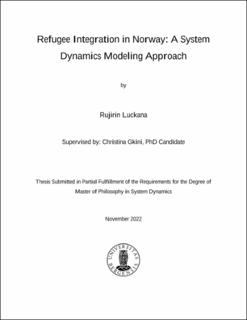| dc.description.abstract | In the past decade, there has been a continuous rise of a number of refugees globally. Many countries are therefore expected to help and welcome more refugees. However, many studies have shown that among the immigrants, the refugees face the most challenges in term of integrating into their new host society. The most popular indicator to measure the integration that has been used thus far is the employment rate. The problem that Norway faces is that the employment rate of refugees is the lowest among other immigration population and almost 30% lower than the national employment rate. The purpose of this research is therefore to integrate the knowledge about the refugee integration and explore other indicators besides employment rate and the dynamics between them in order to have a better understanding of how the refugees integrate in their host country. Furthermore, this research focuses on the mechanisms that trap the refugees in the vicious cycle which prevent them from a fulfilling life in the new country. This research uses system dynamics to capture and quantify the dynamics of refugee integration. The literature review was conducted to form the dynamic hypothesis and the structure of the exploratory model was built based on it. We have identified that the key indicators that contribute to refugee integration are the refugees’ employment rate, their stress level, their social interaction to the local people, their social skill, their job performance, and the perception of local people towards refugees. These indicators are interconnected and form compounding reinforcing loops. Our analysis shows the “entry trap” where refugees is trapped in the unskilled worker job which has a relatively low income thus even when the perception towards refugees and social interactions are raised, these refugees still have a relatively higher stress than average due to the inequality of the income. Most importantly, since the perception towards refugee is not separated between the refugees in an entry level workforce and senior level workforce, the decrease in the perception when the entry refugees do not perform well will eventually have an impact to the senior level refugees who initially start off well. The finding raises two potential helps to the refugee. First is to take measures to reduce the “entry trap”, either by providing training or faster qualification of previous skills, or by providing incentives for businesses to hire refugees in more skilled positions. Secondly, our experiment shows that the increase in social interaction between local people and refugees can ultimately increase their job performance and social skill which increase the perception towards the refugee as well hence, better integration. | |
